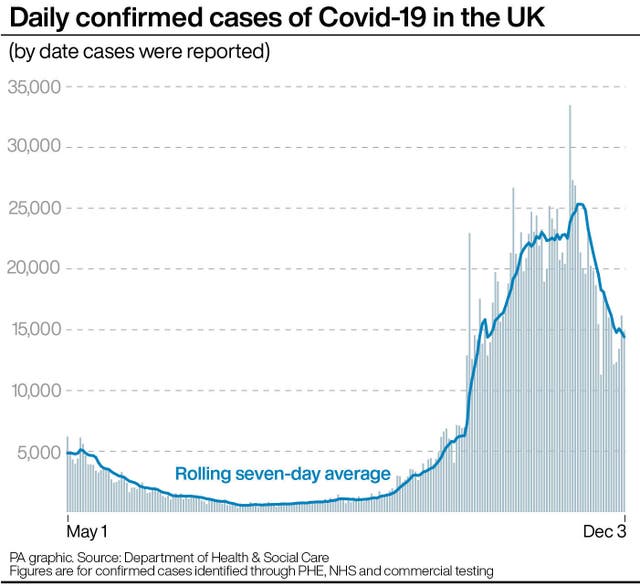The number of new Covid-19 infections in England is continuing to fall, according to the latest estimates.
Figures from the Office for National Statistics (ONS) suggest the incidence rate is now at its lowest since the end of September.
There were an average of 25,700 new cases of Covid-19 per day in private households in England between November 22 and 28, the ONS said – down from an estimated 38,900 new cases per day for the period November 8 to 14.

An estimated 521,300 people in private households in England had Covid-19 between November 22 and 28, the equivalent of around 0.96% of the population.
The figures represent a drop from 633,000 people, or 1.16% of the population, who were estimated to have Covid-19 in the period November 15 to 21.
The ONS figures do not include people staying in hospitals, care homes or other institutional settings.
Data shows the proportion of people testing positive for the virus is estimated to have decreased in all regions of England except the north-east, where rates appear to have levelled off.
But in Wales, the percentage of people testing positive for Covid-19 is no longer falling, the ONS said.

An estimated 18,100 people in private households in Wales had Covid-19 between November 22 and 28, up slightly from an estimated 16,400 people for the period November 15 to 21.
The ONS pointed out that the results should be interpreted with caution because of the relatively small number of tests and low number of positives in its Wales sample.
In Northern Ireland, an estimated 9,500 people in private households had Covid-19 between November 22 and 28, down from an estimated 12,700 people for the period November 15 to 21.
In Scotland, an estimated 40,900 people had Covid-19 between November 22 and 28, down from 45,700 people for November 15 to 21.
A separate survey also suggests that new daily cases of Covid-19 in the UK are continuing to fall, but found that cases in Scotland and Wales have plateaued.
The safest way to spend the festive period is to #StayAtHome.
But to prevent isolation and loneliness, we’re making some small changes to the #coronavirus rules between 23-27 December.
Read this thread to find out more ⬇
— Scottish Government (@scotgov) November 26, 2020
The Zoe Covid Symptom Study UK Infection Survey found that there are 20,497 daily new symptomatic cases of the virus in the UK on average over the two weeks up to November 29, excluding care homes.
This compares to 29,311 daily new symptomatic cases a week ago and more than 42,000 six weeks ago, the researchers said.
The survey found that in Scotland, cases have fallen to the same levels of the end of September, but recently plateaued and there are still around 40,000 infectious individuals.
It found that in Wales, cases have fallen to around the same level as the end of the September but have started to rise again.
Tim Spector, lead scientist on the Zoe Covid Symptom Study app and professor of genetic epidemiology at King’s College London, said it was “encouraging” to see the falling rates, but warned against complacency.

“It’s encouraging to see rates are still falling across most of the UK, and we’re now below 21,000 cases, less than half the peak of the second wave we saw in October.
“However, while we are also seeing steady falls in admissions now, it’s important that we aren’t complacent.
“Even though the UK will start the vaccine rollout next week, many of us won’t be getting one for a few months, so keeping the numbers low and under control is really important for the NHS.
“I’m confident that Zoe’s app data really is the most up-to-date picture we have,” he said.
The Zoe Covid Symptom Study UK Infection Survey figures are based on around one million weekly reporters and the proportion of newly symptomatic users who have positive swab tests.
The latest survey figures were based on data from 11,124 swab tests done between November 15 to 29.




Comments: Our rules
We want our comments to be a lively and valuable part of our community - a place where readers can debate and engage with the most important local issues. The ability to comment on our stories is a privilege, not a right, however, and that privilege may be withdrawn if it is abused or misused.
Please report any comments that break our rules.
Read the rules here